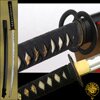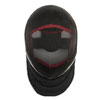|
|
|
 |
|
| Windlass Classic Medieval Sword (500020s) |
Points: 16

|
Sword is an Oakeshott Type X with a Type I pommel and a Type VII crossguard. The long and wide fuller on this blade lightens the overall sword and make it possible to deliver fast and shearing cuts, capable of cutting through the mail and padding that were worn during the period. The long guard offers good protection from an opponent's shield or blade, while the classic wheel pommel brings the sword very nicely into balance. This type of sword was in service for a long period of time throughout all of Europe. Made by Windlass Steelcrafts.
|
|
|
|
|
|
 |
|
| Hanwei Revolutionary War Hanger (SH2375) |
Points: 13
|
Based on an original of the period, our Revolutionary War Hanger (or Cutte) is accurately sized and antiqued to replicate a museum piece. The fully tempered, blunt edged, high carbon steel blade has a distal taper, with fullers on both sides along the spine, and is light and quick. The hilt fittings are cast in solid steel, matching the locket and chape of the leather-covered scabbard.
|
|
|
|
|
|
 |
|
| Cheness Deluxe Carbon Steel Iaito (Iaito-1045) |
Points: 15


|
It is constructed in exactly the same way a carbon steel katana is... only blunted on the cutting edge. Hand forged, hand polished, full length nakago (tang), double mekugi (retaining pin). Perfect for those that want to practice kata using an iaito with the weight of a katana.
|
|
|
|
|
|
 |
|
| Hanwei Practical Iaito |
Points: 12

|
Iaito have long been the preferred training tools for safe practice of the many Japanese sword drawing arts typically known as Iaido. While not designed for sword-on-sword contact or actual test cutting, the un-edged iaito is perfectly weighted and balanced for its designed task of safe, repetitive drawing practice.
Made of a special stainless steel, the blades are much more durable than iaito blades made from aluminum alloy, with a "live" feel and much superior rigidity. Through a special tempering process, these Iaito blades eliminate the brittle behaviour sometimes associated with stainless steel, while retaining its low maintenance and rust-resistant qualities. These very affordable Iaito are the ideal training tools for safely praciticing this ancient art.
White Same w/ Black Cotton Ito & Sageo
Etched Wave Tsuba, Fuchi & Kashira
Copper Menuki, Habaki, Seppa & Shitodome
|
|
|
|
|
|
 |
|
| Hanwei Musashi Iaito |
Points: 28
|
The Musashi Iaito provides an economical yet authentic sword for the Iaido practitioner. Available in 3 blade lengths (27, 28, 29) to perfectly match your needs. The blade is unedged for safety and forged from steel for more precise weight and balance than an aluminum blade can offer. The blade is also maintenance free, providing a lifetime of practice without worry of rust or tarnish. Miyamoto Musashi, arguably the most famous swordmaster in Japanese history, fought more than 60 duels before retiring and writing his famous treatise on swordplay, the "Book of Five Rings". Development of the two-sword style of swordplay, with the Daito (long sword) and Wakizashi being used together, is credited to Musashi. Mounted in black, the Musashi Elite is faithful to the original down to the famous double-ring iron tsubas. The tsuka-ito is in leather over ray skin.
|
|
|
|
|
|
 |
|
| WKC Dragonfly Iaito |
Points: 16

|
Stainless steel hand-forged Iaito : The Dragonfly-Iaito is a high quality iaito specially made for Training.
Hand-forged curved blade with Bohi (groove) and Chu-Kissaki tip. Stainless steel. Hamon made with sandblasting. The hardness of the Mune and of the Ha (blade edge) is 55° HRC Rockwell.
Musashi Tsuba:
JAP08BW271, JAP08BW281, JAP08BW291, JAP08BW301
Round Tsuba:
JAP08BW272, JAP08BW282, JAP08BW292, JAP08BW302
|
|
|
|
|
|
 |
|
| Cold Steel Mini Buckler (92BKPA) |
|
Mini Buckler by Cold Steel. The fist-sized Mini Buckler is smaller and more maneuverable at deflecting blows than our larger models. Its size gives it distinct blocking and defense advantages in situations where a larger buckler might be an impediment.
|
|
|
|
|
|
 |
|
| Cold Steel Soldiers Targe Shield (92BKPL) |
Points: 4
|
Cold Steel Soldiers Targe Shield. New for 2020, our Soldier's Targe. While very similar to our Medieval Buckler, it's about twice the size and just as stout and reliable. Appropriate for training with all non steel swords, its sure to provide years of hard service.
|
|
|
|
|
|
 |
|
| Soldier’s Buckler Battlecry (300501) |
Points: 2

|
This Soldier’s Buckler is from Windlass Steelcrafts Battlecry collection. Designed specifically to be used and made from 1065 high carbon steel with a darkened, battle-hardened finish and tempering to a low 50's RC. This fist shield has gone through rigorous testing.
The hands-on nature of the manufacturing by master smiths makes this line unique. Includes custom packaging and certificate of authenticity signed by each smith that touched your shield through every step of the forging process.
|
|
|
|
|
|
 |
|
| Gladiator Helmet of the Spaniard (880015) |
Points: 15
|
Original licensed product from the classic movie Gladiator.
Maximus Decimus Meridius (Russell Crowe) fighting as the Spaniard wore this helmet in the arena.
Helmet features an antiqued steel finish with an adjustable liner. Includes stand.
|
|
|
|
|
|
 |
|
| Gladiator Helmet of General Maximus (880013) |
Points: 20

|
Original licensed product from the classic movie Gladiator.
Maximus Decimus Meridius (Russell Crowe) wore this helmet as general before he became a gladiator.
Made of hand worked steel with a coating of antique brass, it includes a real horsehair crest and an adjustable liner. This helmet is based directly from the screen-worn prop and is worthy of any Roman general. A silver-plated wolf's head is fixed to the front, inlayed leather along the sides and an adjustable cloth liner makes this helmet stunning as well as practical. Display stand is included. Made by Windlass Steelcrafts.
|
|
|
|
|
|
 |
|
| Cold Steel Medieval Buckler (92BKPB) |
Points: 3
|
Medieval Buckler by Cold Steel. Essentially, a Buckler is a small shield about the size of a large dinner plate. It often accompanied a swordsman as an aid in defense. The Cold Steel training replica is stoutly made and has a thick, sturdy, raised boss to protect the hand, and a rugged handle that will withstand plenty hard of use.
Always wear eye protection and appropriate equipment when training.
Not for use when training against metal weapons.
|
|
|
|
|
|
 |
|
| Red Dragon HEMA Tournament Fencing Mask - 1600N |

|
Our Red Dragon HEMA Tournament Fencing Mask has been developed for the serious practitioner. For many HEMA activities our standard Red Dragon HEMA Mask will suffice, but if you are looking for something with a higher level of protection, or looking to fight in tournaments, our Red Dragon Tournament Fencing Mask will perfectly suit your needs. This CEN 2 mask comes in HEMA Black and features a 1600 newton bib, removable washable liner (handwash only) and heavy-duty adjustable strap. Available in Small, Medium, Large and Extra Large.
|
|
|
|
|
|
 |
|
| Red Dragon Fencing Mask |

|
At last! The Knight Shop's own brand coaching mask comes to you at a fraction of the cost of other coaching masks on the market.
This fantastic mask features a black mesh and removable (washable) red liner. The bib on this mask is rated at 350 Newtons.
Available in 4 sizes.
Key Features
- Removable liner
- 350 Newton rating.
|
|
|
|
|
|
 |
|
| Plain Buckler |
Points: 3

|
Bucklers, shields gripped with the fist, were frequently used in combination with single-handed swords from the high middle ages to the Renaissance. They are useful for shielding from, as well as giving out blows.
Our ULFBERTH® bucklers are available in three sizes (S, M, L). The handles are riveted and wrapped in leather.
|
|
|
|
|
|
|
|
Tags:
martial arts, katana, iaito, sword, fencing, tonfa, boken, bokken, kama, shinai, samuraj, judo, karate, kenjutsu, kenjitsu, ninja, kungfu,
|
















